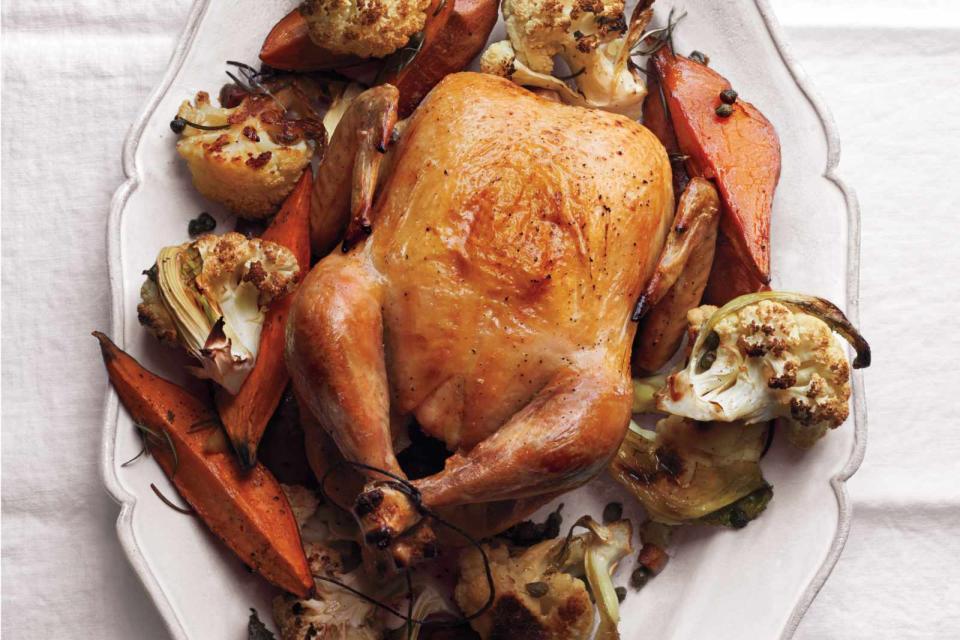How Roasting Is Different From Baking—and Why It Matters
The terms are often used interchangeably, but each has its own defining characteristics.

Some cooking methods are easier to understand than others, some have overlap, and some appear to mean different things to different people. When it comes to roasting versus baking, the difference can stump even seasoned chefs. These terms, which both involve making something in the oven, are often used interchangeably. We're clear that you bake chocolate chip cookies. But are you roasting chicken? Or are you making baked chicken? We consulted food professionals to get clarity on the distinctions and similarities between roasting and baking—and found some exceptions to standard culinary schools of thought.
Meet Our Expert
Cammie Kim Lin, food writer and professor at New York University
Leah Su Quiroga, former head chef at Chez Panisse and co-author of (Serious) New Cook: Recipes, Tips, and Techniques
Ronna Welsh, chef and founder of Purple Kale Kitchenworks
Related: When You Should Put a Lid on a Pot on the Stove—and When You Shouldn't
Roasting vs. Baking
"Not everyone is going to agree, but to us, the key differences [between roasting and baking] have to do with the primary ingredients, the temperature, and the goal," says Cammie Kim Lin, a food writer and professor at New York University. She and her sister, Leah Su Quiroga, a former head chef at Chez Panisse in Berkeley, California, co-wrote (Serious) New Cook: Recipes, Tips, and Techniques, an instructional resource for fledgling cooks striving to expand their kitchen skills.
A Difference in Temperature
On the temperature front, the differences between roasting and baking are fairly cut and dry. Both roasting and baking involve cooking with dry, ambient heat, usually in an oven. Roasting temperatures are typically above 400 degrees Fahrenheit while baking temperatures are about 375 degrees and below.
Baking Brings Transformation
Baking, with its slightly lower temperature, often involves a metamorphosis—converting liquids to solids, for instance. "Baking is more associated with a cooking process that transforms multiple ingredients into something totally new, like a dough into bread, a batter into a cake, or an egg mixture into a quiche," says Lin.
Roasting Has Wider Applications
Lin and Quiroga note that roasting typically involves whole, solid foods like chicken or vegetables; oils, inherent or added, quicken caramelization. "You'd be surprised how many foods roast well. Almost anything will roast nicely if it has enough fat to help it along," says Lin.
Roasting is an ideal cooking method for fatty meats, like pork shoulder or belly, but there's no need to stop with animal proteins. "Hearty vegetables like sweet potatoes, squashes, cauliflower, broccoli, and root vegetables all roast up marvelously with nothing more than a good drizzle of olive oil and some salt," says Lin. "The key is to let them go long enough to caramelize on the outside. (A heavy sheet pan or roasting dish lined with parchment paper helps.)"
Roasting also always aims to brown, whether it's chicken skin or broccoli, explains Ronna Welsh, author of The Nimble Cook and the owner of and chef at Purple Kale Kitchenworks, an online cooking school. With roasting, the heat concentrates or intensifies an ingredient's flavor or makes its texture more approachable, she adds.
Convection Roast vs. Bake
Convection ovens have a fan in the back that can be turned on to circulate the air around the inside of the oven cavity. This air circulation eliminates hot and cold spots in the oven and means food cooks faster and more evenly.
Where it can get confusing is if your oven has more than one convection setting. Some have the option for "convection bake" and "convection roast," and there’s no standard for what these settings mean.
Related: How to Convert Your Favorite Recipes for a Convection Oven
Convection Roast
Convection roasting often uses both the top and bottom heating elements and a faster fan. Choose convection roasting when you are roasting vegetables, chicken, or other roast meat.
Convection Bake
Generally, convection baking means the bottom heating element of the oven is being used and indicates a more gentle airflow. It should be selected when you are baking cakes, cookies, and pies.
Culinary Crossover
Lin and Quiroga also find that roasting fruit, like strawberries or apricots, with a sprinkle of sugar to mix with natural juices, has delicious outcomes. But wait—doesn't roasting refer to savory foods, while baking pertains (mostly) to sweet treats? "That's one assumed difference between the two terms, but it doesn't hold up. For instance, you can 'bake' squash or potatoes, or a pan of ziti," says Welsh. "We 'roast' potato wedges, but 'bake' whole potatoes, even though, in each case, we want similar transformations: crisp skins and fluffy interiors."
Lin and Quiroga point out other examples that don't square with a hardline rule of thumb. "'Slow roasting' is a thing, too, and that happens at lower temperatures," says Lin.
Expanding Definitions
Obviously, there are marked differences between roasting and baking, but sometimes the definitions simply need to be expanded—and other circumstances may play a part in the terms used, like regional cooking norms. "When we were growing up in Michigan, everyone made baked chicken, not roasted chicken," Lin says.
Read the original article on Martha Stewart.

